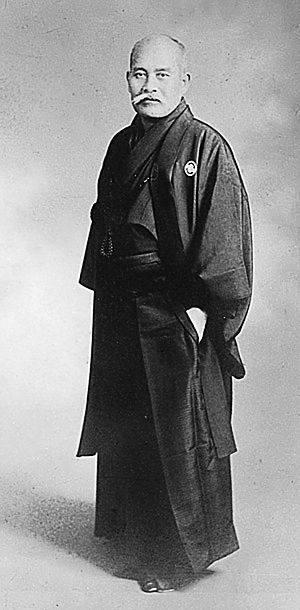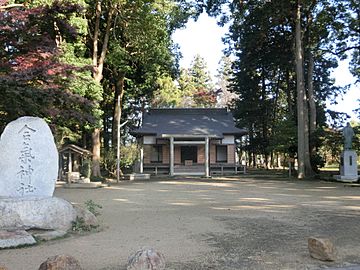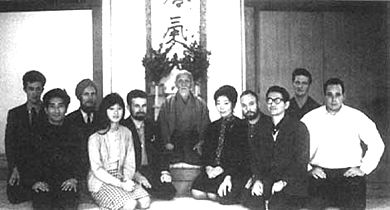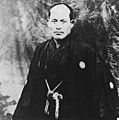Morihei Ueshiba facts for kids
Quick facts for kids Morihei Ueshiba |
|
|---|---|
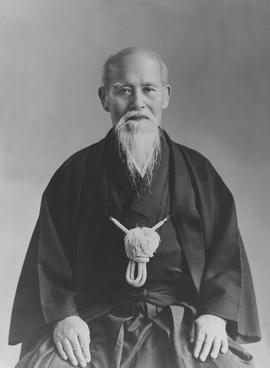 |
|
| Born | December 14, 1883 Tanabe, Wakayama, Japan |
| Died | April 26, 1969 (aged 85) Iwama, Ibaraki, Japan |
| Native name | 植芝 盛平 |
| Other names | Moritaka Ueshiba (植芝守高), Tsunemori (常盛) |
| Style | Aikido |
| Teacher(s) | Takeda Sōkaku |
| Children |
|
| Notable students | see List of aikidoka |
Morihei Ueshiba (植芝 盛平, Ueshiba Morihei, December 14, 1883 – April 26, 1969) was a Japanese martial artist. He founded the martial art of aikido. People often call him "the founder" (Kaiso) or "Great Teacher" (Ōsensei).
Morihei Ueshiba was the son of a landowner. He grew up in Tanabe, Wakayama. When he was young, he studied many different martial arts. He also served in the Japanese Army during the Russo-Japanese War. After leaving the army in 1907, he moved to Hokkaidō. There, he led a group of people starting a new settlement. In Hokkaido, he met and learned from Takeda Sōkaku. Takeda Sōkaku was the founder of Daitō-ryū Aiki-jūjutsu.
In 1919, Ueshiba left Hokkaido. He joined the Ōmoto-kyō movement, a spiritual group, in Ayabe. He taught martial arts and opened his first training hall (dojo) there. In 1924, he went on a trip to Mongolia with the Ōmoto-kyō leader, Onisaburo Deguchi. They were captured by Chinese soldiers but later returned to Japan. The next year, Ueshiba had a special spiritual experience. He felt a "golden spirit" cover his body. After this, his martial arts became softer. He focused more on controlling ki, which is like life energy.
Ueshiba moved to Tokyo in 1926. He set up what would become the main Aikido training center, the Aikikai Hombu Dojo. He became well-known in martial arts. He taught at his dojo and other places in Japan. This included some military schools. After World War II, the main dojo in Tokyo closed for a while. But Ueshiba had moved to Iwama. He continued to train at his dojo there. From the end of the war until the 1960s, he helped spread Aikido in Japan and other countries. He passed away in 1969.
After Ueshiba's death, his students continued to teach Aikido. Many of them became famous martial artists themselves. Today, Aikido is practiced all over the world.
Contents
Early Life and Training in Tanabe (1883–1912)
Morihei Ueshiba was born on December 14, 1883. He was born in a village that is now part of Tanabe, Wakayama. He was the fourth child but the only son of Yoroku and Yuki Ueshiba.
Young Morihei grew up in a comfortable home. His father, Yoroku, was a successful farmer and a local politician. His mother, Yuki, came from an important local family. Morihei was a weak and sickly child. He loved to read books. His father encouraged him to try sumo wrestling and swimming. His father also told him stories about his strong great-grandfather, Kichiemon, a samurai. Morihei saw his father attacked by rivals. This made him realize the importance of strength.
His elementary school teacher, Tasaburo Nasu, was a Shinto priest. He introduced Morihei to the Shinto religion. Morihei also studied at a Buddhist temple. He learned about special chants and rituals. His interest in spiritual things grew. He left school early to study accounting. He worked at a tax office for a short time. But he didn't like the job. In 1901, he moved to Tokyo. He tried to open a stationery business. But he got sick and returned to Tanabe less than a year later. Soon after, he married his childhood friend, Hatsu Itokawa.
In 1903, Ueshiba was called to join the army. He was too short at first. So, he stretched his spine by hanging from tree branches with weights. He grew taller and passed the test. He served in the Russo-Japanese War and became a sergeant. He left the army in 1907. He returned to his father's farm in Tanabe. In 1911, he and Hatsu had their first child, a daughter named Matsuko.
Ueshiba studied several martial arts when he was young. He was known for his great physical strength. In Tokyo, he learned Kitō-ryū jujutsu. He also studied Shinkage-ryū and Yagyū Shingan-ryū. In 1911, he learned judo in Tanabe. His father even built a dojo (training hall) at their home for him.
Life in Hokkaidō (1912–1920)
In the early 1900s, the government offered help to people moving to Hokkaidō. This was Japan's northernmost island. In 1910, Ueshiba traveled to Hokkaido to find a good place for a new settlement. He found a suitable spot in Shirataki. Even though he faced hardships like snowstorms, he was excited about the project. He returned to Tanabe and gathered 85 families to join him. They became the Kishū Settlement Group. They founded the village of Yubetsu (later Shirataki village) in 1912.
The first few years were tough due to bad soil and weather. But the group managed to grow mint and raise animals. The timber industry also helped the village grow. By 1918, over 500 families lived there. A fire destroyed the village in 1917. Ueshiba helped lead the rebuilding efforts. In 1918, his first son, Takemori, was born.
In March 1915, Ueshiba met Takeda Sōkaku in Engaru, Hokkaido. Takeda Sōkaku was the founder of Daitō-ryū Aiki-jūjutsu. Ueshiba was very impressed with Takeda's martial art. He spent a month studying with him. He even built a dojo at his home and invited Takeda to stay there. In 1922, Ueshiba received a teaching license from Takeda. Ueshiba then became a representative for Daitō-ryū. He traveled with Takeda and taught the system to others. Their relationship was sometimes difficult.
Spiritual Growth in Ayabe (1920–1927)
In November 1919, Ueshiba learned his father was very ill. He left Shirataki to go back to Tanabe. On the way, he stopped in Ayabe. He wanted to visit Onisaburo Deguchi, the leader of the Ōmoto-kyō religion. Ueshiba stayed at the Ōmoto-kyō headquarters for several days. Deguchi told him not to worry about his father. When Ueshiba returned to Tanabe, his father had already passed away.
Within a few months, Ueshiba moved his family to Ayabe. He decided to become a full-time student of Ōmoto-kyō. In 1920, Deguchi asked Ueshiba to be the group's martial arts teacher. Ueshiba built a dojo there. He also taught Takeda's Daitō-ryū in a nearby area. Sadly, his second son, Kuniharu, was born in Ayabe in 1920 but died that same year. His son Takemori also passed away.
Deguchi encouraged Ueshiba to create his own martial art style, called "Ueshiba-ryū." Many Ōmoto followers came to study with him. Ueshiba also took on important roles in the group. He became Deguchi's assistant and led youth and fire services.
Ueshiba's connection with Deguchi led him to meet some powerful people in Japan. He became friends with the philosopher Shūmei Ōkawa. He also met other important figures. Ueshiba believed in world peace. However, the Ōmoto-kyō group believed this peace would come from Japan ruling other nations.
In 1921, the Japanese government raided the Ōmoto-kyō compound. They arrested Deguchi. Ueshiba's dojo was not damaged. He worked with Deguchi to rebuild the center. His son Kisshomaru was born in 1921.
In 1924, Deguchi led a group, including Ueshiba, to Mongolia. Deguchi wanted to create a new spiritual kingdom there. They were arrested by Chinese authorities. Luckily, the Japanese group was released and sent back to Japan. Deguchi was imprisoned. During this trip, Ueshiba was given a Chinese name, "Moritaka," which he liked and used sometimes.
After returning to Ayabe, Ueshiba focused on spiritual training. He often went to the mountains or performed misogi (purification rituals) under waterfalls. His martial arts skills grew. Many martial artists challenged him. Some became his students after he defeated them. In 1925, he gave a demonstration in Tokyo. A high-ranking official, Admiral Isamu Takeshita, asked him to teach the Imperial Guard. But Ueshiba disagreed with some government officials. He canceled the training and returned to Ayabe.
Teaching in Tokyo (1927–1942)
In 1926, Admiral Takeshita invited Ueshiba to Tokyo again. Ueshiba went, but he became very ill. Deguchi visited him and told him to return to Ayabe. Ueshiba was also questioned by the police because of his ties to Deguchi. This made him angry, and he went back to Ayabe. Six months later, with Deguchi's blessing, Ueshiba and his family moved to Tokyo for good.
This move allowed Ueshiba to teach important people. He taught politicians, military leaders, and even members of the Imperial family. He was no longer an unknown martial artist. He became a respected sensei. The Ueshiba family first lived in Shirokane. But their growing number of students needed more space. They moved several times, finally settling in a specially built hall in Shinjuku. This hall was first called the Kobukan. It later became the Aikikai Hombu Dojo, the main Aikido center. While it was being built, Kanō Jigorō, the founder of judo, visited Ueshiba.
Ueshiba was invited to teach at military schools. This was because of his good relationships with military leaders. He taught at the Imperial Japanese Naval Academy. He also taught at the Nakano Spy School. However, Aikido was later thought to be too complex for the spy students. Karate was chosen instead. He also taught at the Imperial Japanese Army Academy. This happened after he defeated General Makoto Miura in a challenge.
Ueshiba met Takeda Sōkaku for the last time around 1935. Ueshiba was teaching in Osaka at the time. Takeda openly criticized Ueshiba's martial arts. He seemed to want to take over the classes. Ueshiba left Osaka during the night. He bowed to Takeda's residence and avoided contact with him afterward. Between 1940 and 1942, Ueshiba visited Manchukuo (Japanese-controlled Manchuria). He was the main martial arts instructor at Kenkoku University. While there, he defeated a sumo wrestler named Tenryū Saburō in a demonstration.
In 1935, the government cracked down on Deguchi's group again. This was called the "Second Ōmoto Incident." The Ayabe compound was destroyed. Most of the group's leaders were imprisoned. Ueshiba had moved to Tokyo, but he still had ties to Ōmoto-kyō. He expected to be arrested. But he had a good relationship with the local police chief, Gīchi Morita, who had been his student. So, he was questioned but released without charges.
In 1932, Ueshiba's daughter Matsuko married the swordsman Kiyoshi Nakakura. Nakakura was adopted as Ueshiba's heir. But the marriage ended after a few years. Nakakura left the family in 1937. Ueshiba later chose his son Kisshomaru as the heir to his martial art.
The 1930s saw Japan's military activity increase. Ueshiba was worried about war. He tried to prevent the conflict that became World War II. He was part of a group that tried to arrange for aviation fuel to be sent from the United States to Japan. This was against the oil embargo at the time. This effort failed. In 1941, Ueshiba also went on a secret trip to China. He hoped to arrange peace talks. But he arrived too late to meet the Chinese leader.
Life in Iwama (1942–1969)
Starting in 1935, Ueshiba bought land in Iwama. By the early 1940s, he owned about 17 acres of farmland there. In 1942, he became tired of the war and politics in Tokyo. He left the city and moved to Iwama for good. He lived in a small farmer's cottage. There, he founded the Aiki Shuren Dojo, also known as the Iwama dojo. He also built the Aiki Shrine. This was a special shrine dedicated to the "Great Spirit of Aiki." During this time, he traveled a lot in Japan, teaching Aikido.
After World War II, teaching martial arts was forbidden for a while. But Ueshiba and his students continued to practice in secret at the Iwama dojo. The main dojo in Tokyo was being used to help people displaced by the bombing. During this period, Ueshiba met Koun Nakanishi, an expert in kotodama (the spiritual power of words). Studying kotodama became one of Ueshiba's passions. Nakanishi's work inspired Ueshiba's idea of takemusu aiki.
Ueshiba's new home in Iwama allowed him to focus on farming. This was his second great passion. He came from a farming family and had spent much of his life working the land. He saw farming as a good partner to martial arts. Both needed physical effort and strong dedication. Farming also helped hide his martial arts training from the government. It also provided food for Ueshiba, his students, and local families during a time of food shortages.
The ban on teaching Aikido was lifted in 1948. This happened when the Aiki Foundation was created. After the war, Ueshiba mostly retired from teaching Aikido. He gave most of the work of running the main dojo to his son Kisshomaru. Instead, Ueshiba spent his time in prayer, meditation, calligraphy, and farming. He still traveled to promote Aikido. He even visited Hawaii in 1961. He also appeared in a TV show about Aikido in 1960.
In 1969, Ueshiba became ill. He led his last training session on March 10. He passed away on April 26, 1969. His body was buried at Kozan-ji Temple in Tanabe. He was given a special Buddhist name after his death. Two months later, his wife Hatsu also passed away.
How Aikido Developed
Aikido is a fighting system. It is usually translated as the Way of Unifying Spirit. It focuses on throws, pins, and joint locks. It also uses some striking techniques. Aikido teaches you to protect your opponent. It also helps with spiritual and social growth.
The techniques of Aikido came from Takeda Sōkaku's teachings. The basic moves of Aikido come from his Daitō-ryū system. In his early years of teaching (1920s to mid-1930s), Ueshiba taught Daitō-ryū Aiki-jūjutsu. His early students' notes use the term Daitō-ryū.
The early way of training under Ueshiba was different from later Aikido. It had more techniques. It used more strikes to vital points (atemi). It also used more weapons. The styles of Aikido developed by Ueshiba's students from before the war often show this harder style. Some of these students include Kenji Tomiki, Noriaki Inoue, Minoru Mochizuki, and Gozo Shioda. Many of these styles are called "pre-war styles." Some of these teachers continued to train with Ueshiba after World War II.
During his life, Ueshiba had three important spiritual experiences. These greatly changed his understanding of martial arts. The first happened in 1925. Ueshiba had defeated a naval officer's wooden sword attacks without hurting him.
His second experience happened in 1940 during a purification ritual.
His third experience was in 1942 during World War II. Ueshiba had a vision of the "Great Spirit of Peace."
After these events, Ueshiba slowly moved away from Takeda's teachings. He began to change his art. He called his system by different names over time. These included aiki-jūjutsu, Ueshiba-ryū, Asahi-ryū, and aiki budō. In 1942, his martial art finally became known as Aikido.
As Ueshiba got older, more skilled, and more spiritual, his art also changed. It became softer and gentler. Martial techniques became less important. He focused more on controlling ki. He emphasized kokyū-nage, or "breath throws." These throws are soft and blend with the opponent's movement. Ueshiba regularly practiced cold water misogi and other spiritual rituals. He saw his Aikido studies as part of his spiritual training.
Over the years, Ueshiba trained many students. Many of them later became famous teachers. Some were uchi-deshi, which means they lived and trained with him. Ueshiba had many demands for his uchi-deshi. They had to attend to him all the time. They were training partners, even in the middle of the night. They also helped with his travel, massages, baths, and household chores.
There were about four groups of students. These included:
- Students from before the war (around 1921–1935)
- Students who trained during World War II (around 1936–1945)
- Post-war students in Iwama (around 1946–1955)
- Students who trained with Ueshiba in his final years (around 1956–1969)
Because Ueshiba's martial art changed over his life, students from each group often have different ways of doing Aikido. Few students trained with Ueshiba for a very long time. Only a few studied directly under him for more than five or six years. After the war, Ueshiba and the Hombu Dojo sent some students to other countries. This helped Aikido spread around the world.
Images for kids
See also
 In Spanish: Morihei Ueshiba para niños
In Spanish: Morihei Ueshiba para niños



